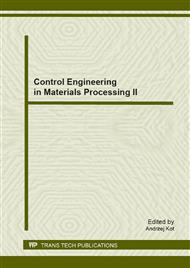p.1
p.8
p.20
p.29
p.40
p.52
p.63
p.70
Determination of Emissivity Characteristics for Controlled Cooling of Nickel-Alloy Forgings
Abstract:
The paper presents the methodology and the results of determination of emissivity coefficient for nickel alloy Inconel 718 in the temperature range predicted for thermomechanical processing of these alloys and its application for correction of temperature during cooling and modeling. The idea presented in the paper is an iterative use of automatic system of temperature measurement and control, facilitated with thermocouples and pyrometer gauge to provide temperature dependent characteristics of the alloy. In addition to estimation of temperature dependence of the emissivity coefficient, the results of cooling tests for simple and complex geometry of nickel alloy forgings are contained, obtained with modeling based on assumption of the determined characteristics. To verify obtained characteristic, they were used in modeling of cooling and compared to those obtained in measurements based on assumption of constant value of emissivity coefficient. Measurement errors obtained were used to indicate show the significance of application of functional dependence in comparison with constant value, as well as, magnitude of error made during temperature measurement or modeling, when neglecting the temperature dependence.
Info:
Periodical:
Pages:
1-7
Citation:
Online since:
September 2013
Authors:
Price:
Сopyright:
© 2014 Trans Tech Publications Ltd. All Rights Reserved
Share:
Citation:


